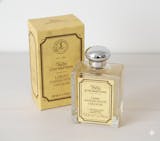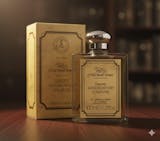Straight Razor Blades: What is Damascus Steel?

Legend has it; this steel bears the mastery of perfect forging techniques—with blades never losing edge even after surviving the deadliest of wars. But for wet shaving and straight razors, what is Damascus steel?
When it comes to the sharpest knives and the swords of legendary warriors in history, Damascus steel blades reign supreme. Its extraordinarily sharp and never-wilting edge accounts for its trailblazing history, being the best blade that the world has ever known.
That is why many traditional shaving aficionados wonder whether Damascus steel may also be the best and ideal base for a straight razor’s blade.
Let’s find out as we break down what Damascus steel is:
- Where is Damascus Steel From?
- Forging a Damascus Steel Blade
- What Makes a Good Straight Razor
- Is Damascus Steel Blade Good for Straight Razors?
Where is Damascus Steel From?
 Damascus steel blades came from Damascus, the ancient capital of Syria and home to the best weapon industry.
Damascus steel blades came from Damascus, the ancient capital of Syria and home to the best weapon industry.
What makes Damascus steel legendary is its forging technique originating from almost 2,000 years ago. Historians believe that the first Damascus steel was birthed in the world’s oldest known capital, Damascus, the metropolis of modern-day Syria, hence, the steel harboring the name.
The city of Damascus was the core of the flourishing craft and weapon industry. And when the Arabs introduced the Indian’s wootz to the local Damascene blacksmiths, their industry thrived exponentially.
Coincidentally, Damascus, the city's name in Aramaic, is darmeśeq, which means “well-watered place.” Despite the capital being on a plateau, Damascus was within the majestic oasis of the Syrian Desert and enriched by the Barada River.
Ancient Damascus, given the nature of its environment, was undoubtedly a place where well-watered land thrives. Therefore, it is why the Christians refer to the capital as their holy lands.
Forging a Damascus Steel Blade

Forging Damascus steel blades from Indian wootz is a 2,000-year-old technique.
Any blade forged in Syria’s old capital was a Damascus steel blade in the old days. However, after the Arabs introduced India’s wootz, the blades received a total revamp.
Today, if you were to ask anyone, “what is Damascus steel?” they will tell you it is a blade that has distinct wave-like patterns and unique banding properties so strong its sharp edge hardly fades. Yet, this most-prized steel is more than that.
What Legends Say
If you want to make your own Damascus steel blade, you will need some dragon blood and the body of a muscular slave—that is, if you’re going to follow the ethereal forging method.The myths go like this: blacksmiths of the past tempered the steel until it glows and cooled down into a royal purple; drowned in Persian dragon blood or green and red European medicine; and finally “plunged into the body of a muscular slave,” a homicidal quenching—whatever that means.
On a more earthly level, blacksmiths from Damascus begin with blocks of wootz—a form of steel from India with great malleability and extraordinary toughness. Unlike other steel, wootz has iron and wood, or charcoal that yields a high level of carbon, about 1.5 percent.
When processed at temperatures as high as 2,300 degrees cooled at room temperature, the steel forms carbide, which is essentially what makes the distinct features of a Damascus steel blade.
Modern Damascus Blade
Unfortunately, the original formula for processing wootz disappeared in the 1700s, and none of today’s metallurgists and blacksmiths have successfully unlocked the mystery. It is only fitting to say that genuine Damascus steel blades are nothing but legends—for now.Yet, many blade manufacturers have taken inspiration from Damascus, and their methods are what make modern Damascus blades. After all, the idea is to create blades that incorporate high-carbon and pattern-wielding ways.
The water patterns engraved on ancient Damascus blades are the forging of different malleability and strength of the metals, wherein blacksmiths combine flexible and strong iron ores. Some of today’s versions are practically stainless steel blades with Damascus patterns.
What Makes a Good Straight Razor
 An excellent straight razor, like Naked Armor's Drian Damascus Straight Razor, has a hefty and sharp blade ideally balanced by a heavy handle.
An excellent straight razor, like Naked Armor's Drian Damascus Straight Razor, has a hefty and sharp blade ideally balanced by a heavy handle.
Now that we have broken down what makes Damascus steel superior to others when it comes to blade work let us talk about straight razors.
Straight razors are classic and quintessential shaving tools during the heydays of traditional wet shaving. It is the original swords, if we may say, of professional barbers. Hence, straight razors are the go-to razors if you want to get the best shave you could ever experience.
With that, shaving aficionados consider straight razors as investments. It is only rightly to note that one needs to find a quality razor to truly get his money’s worth.
An excellent straight razor embodies the following:
-
Starts with Great Steel
The blade is the most crucial part of any razor. And for something that has a cutthroat reputation, straight razor blades need to be made from only the best type of steel.
High-quality stainless steel is the norm for great straight razors. A steel blade needs to have the ideal HRC rating to handle a straight razor's tedious task. HRC rating is what you use to define and measure the hardness of your razor blades.
Anything with a 59-63 HRC level is bound to be one of the best blades you will ever wield on your face for your grooming needs, like Naked Armor’s Damascus straight razors with 62-63 HRC level.
-
Honed to Perfection
The honing process is what makes the edge of your straight razor attain its infamous bite. Honing produces a sharp edge, which embodies the very purpose of a straight razor. So, when looking for a straight razor, look for a manufacturer that discloses the basics of their honing process.
-
Has a Hardwood Handle
One of the most intimidating parts of shaving using a straight razor is the learning stage. Your straight razor can only do so much if you do not know how to hold one.
Here is the problem: straight razor blades tend to be heavy, and the handle can be too light. That is why straight razors slipped in between the hands of discouraged beginners. The result? A lousy shave and a heavily-nicked face.
Case in point, an excellent straight razor would need to have a hardwood handle. Hardwood is ideal for offsetting the blade’s weight, providing the right heft to avoid mishaps.
Nevertheless, if Damascus steel was the supreme blade of its time, straight razors transcend any razor that will ever come in this lifetime and the lifetime of future generations. Despite the modern design evolutions that King Camp Gillette kickstarted, the convenience that plastic razors impose could never outweigh the quality and prime of straight razors.
Is Damascus Steel Blade Good for Straight Razors?
 Damascus blades with a 62-63 HRC level works best with straight razors.
Damascus blades with a 62-63 HRC level works best with straight razors.
So, what’s the real deal? Is a Damascus steel blade suitable for straight razors?
The takeaway is that genuine and authentic Damascus, from the Ancient wartimes, do not make excellent straight razor blades. Meanwhile, modern Damascus blades can be great for straight razors, according to some users in this Badger&Blade forum.
Modern Damascus blades have the strength and flexibility that a straight razor needs and its robustness allows it to stay sharp even after years of daily shaving—only accurate if you strop every time you shave. Meanwhile, the flexibility and malleability of Damascus steel allow any razor bearing it to be honed to perfection—excellent for straight razor maintenance.
Yet the overall efficiency of your straight razor still relies on how well you can wield it. That is why Naked Armor chose to perfect their quest in creating the Drian Damascus Straight Razor and Esclabor Damascus Straight Razor.
With a handle made of premium walnut and ebony wood surrounded by steel and a 72-layered Damascus steel blade with an HRC of 62-63, the Drian & Esclabor undoubtedly has the perfect blade-to-handle weight ratio and shatter-free edges, being living proof that Damascus steel blades are great for straight razors and wet shaving.
More Naked Armor Reads:
How To Hone A Straight Razor
How To Get The Best Barber Shave At Home
Benefits Of Using A Straight Razor




























Leave a comment